OptimumP2P is coming. Currently in private testnet with a group of leading Ethereum validators and node operators, OptimumP2P boosts the speed and efficiency of communicating data between nodes. It leverages Random Linear Network Coding, a data coding technique our Co-founder Prof. Muriel Medard developed at MIT. RLNC is built specifically for achieving high throughput at scale on decentralized networks. To give a better understanding of how OptimumP2P works and its effects on blockchain ecosystems we’ll be walking through validator implementation, interaction with existing chain architecture, and specific benefits for each of the following groups:
-
Validators & Stakers
-
L1/L2 Chains
-
Apps
-
End Users
What Does Standard Data Propagation Look Like Today?
And why is fast propagation crucial to scaling/speeding up chains?
When you make a transaction onchain it goes through several steps to reach confirmation. On Ethereum, this starts with the transaction being sent to an RPC node which connects the app you’re using to the blockchain. It then enters the mempool, a temporary holding area where pending transactions are collected before being included in a block. Next, the block is built and sent to the proposer via a relayer. The proposer is a randomly selected validator who kicks off the propagation process, broadcasting the chosen block out to the rest of the network. Once enough nodes to reach a ⅔ supermajority have received and attested to the block it is considered confirmed. Broadcasting proposed blocks around to other nodes is where OptimumP2P comes into play, speeding up that step significantly.
Today, Ethereum blocks are propagated using Gossipsub, a method of gossip that does not use data encoding. The advantage OptimumP2P has over Gossipsub is its use of erasure coding, specifically Random Linear Network Coding (RLNC). Coding the data in this fashion makes propagation faster, more reliable, and more bandwidth efficient.
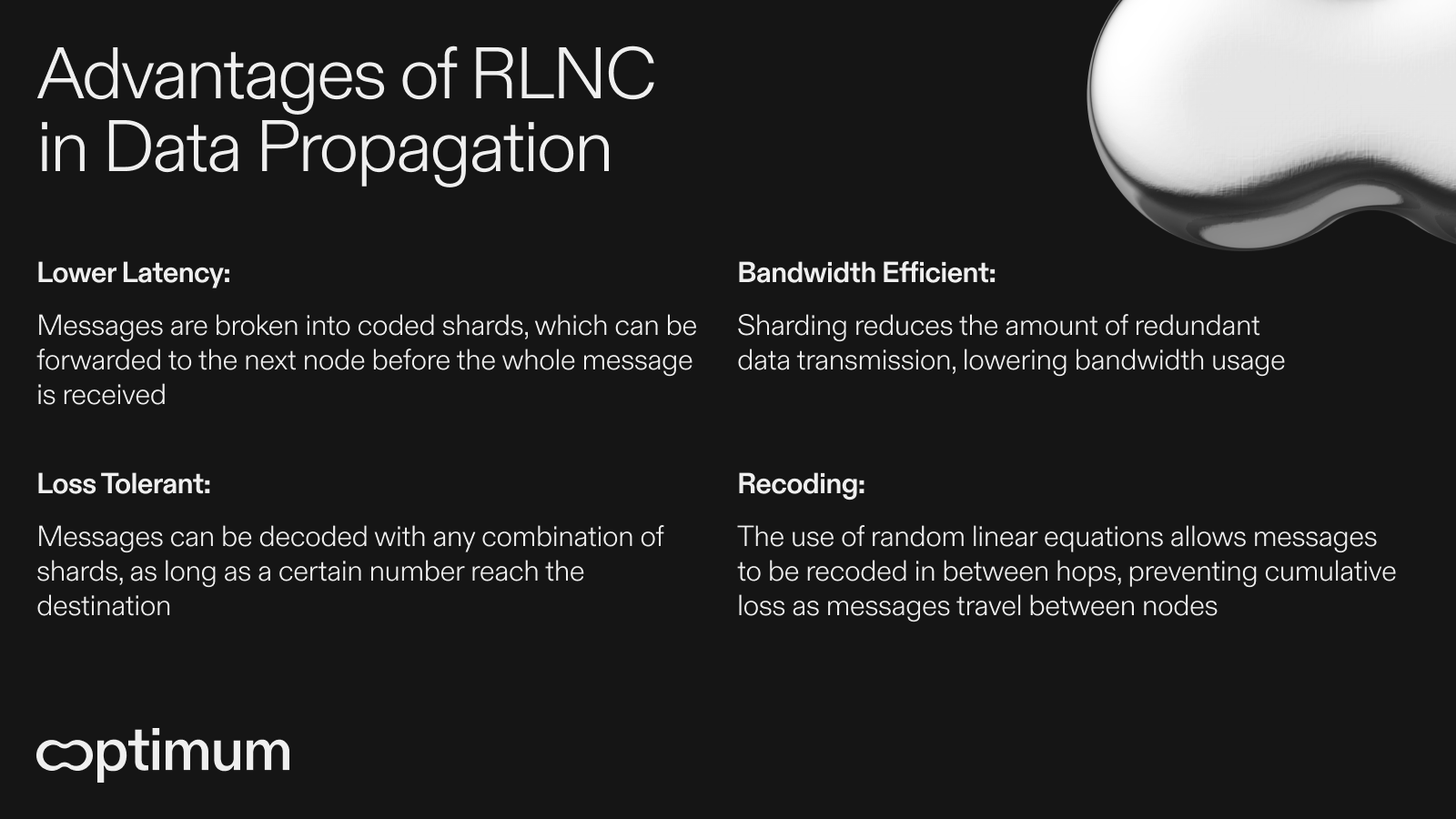
Early OptimumP2P testing has shown 50%+ latency reduction with significantly less variation vs. GossipSub using average block-sized messages. As message size and frequency are increased, the performance gap widens until GossipSub can no longer reliably deliver messages while OptimumP2P remains highly performant.
It’s worth noting that approaches to data propagation vary by chain, and some already make use of erasure coding. Take Solana for example, which uses Reed-Solomon coding to achieve relatively fast propagation. However, OptimumP2P is chain-agnostic and RLNC is a significant upgrade to currently used codes such as Reed-Solomon & Raptor codes.

You can find a full analysis of RLNC vs. other erasure codes in our previous blog posts.
Bottom line: OptimumP2P makes any chain faster. We are actively exploring opportunities to bring OptimumP2P to other L1 and L2 chains in addition to Ethereum. Now how do we implement OptimumP2P?
Permissionless Validator Level Implementation
OptimumP2P propagates blocks for validators. It is implemented on a validator’s machine, running as a sidecar alongside their Ethereum client software. OptimumP2P will be permissionlessly accessible, allowing validators to opt in to the fast data propagation network. Overhead is minimal, meaning any validator can take advantage of OptimumP2P regardless of hardware specs.
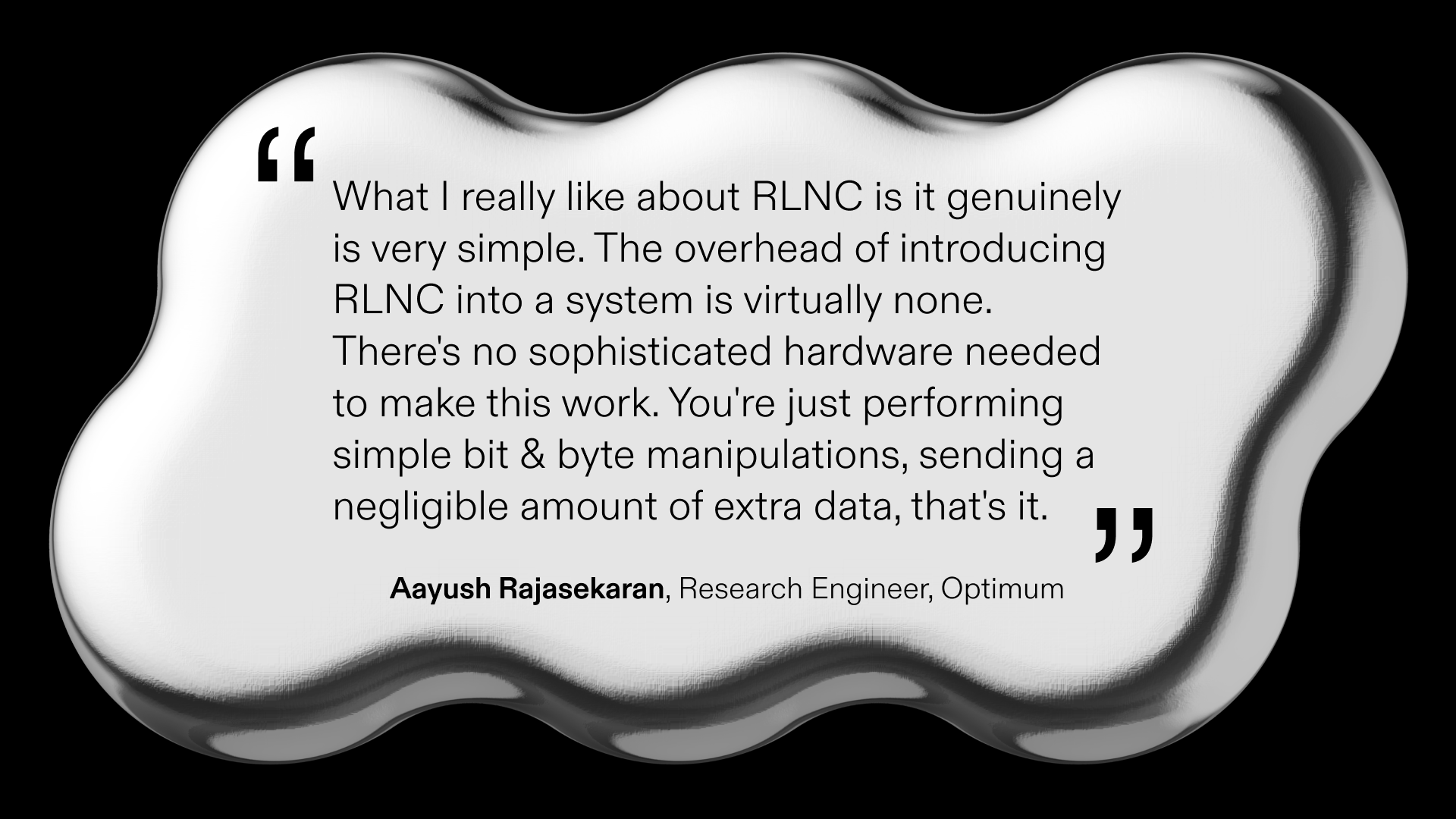
Now let’s look at how the fast data propagation process works. First, any received blocks are picked up from a validator by the Optimum Agent, a piece of software running on their machine that reads directly from their Ethereum Client. The block data is passed to the Optimum Service, an adjacent piece of software on the validator’s machine, where it is then broken into small coded shards (using RLNC) and sent out to other nodes. Once a node receives enough shards it can reconstruct the full block, but even before the full block is reconstructed a node can begin forwarding any received shards on to the next node. This is one of RLNC’s special properties that makes it so useful for fast data propagation. In addition to block propagation, OptimumP2P can be leveraged for faster transaction relay from RPC node to mempool, and faster blob propagation.
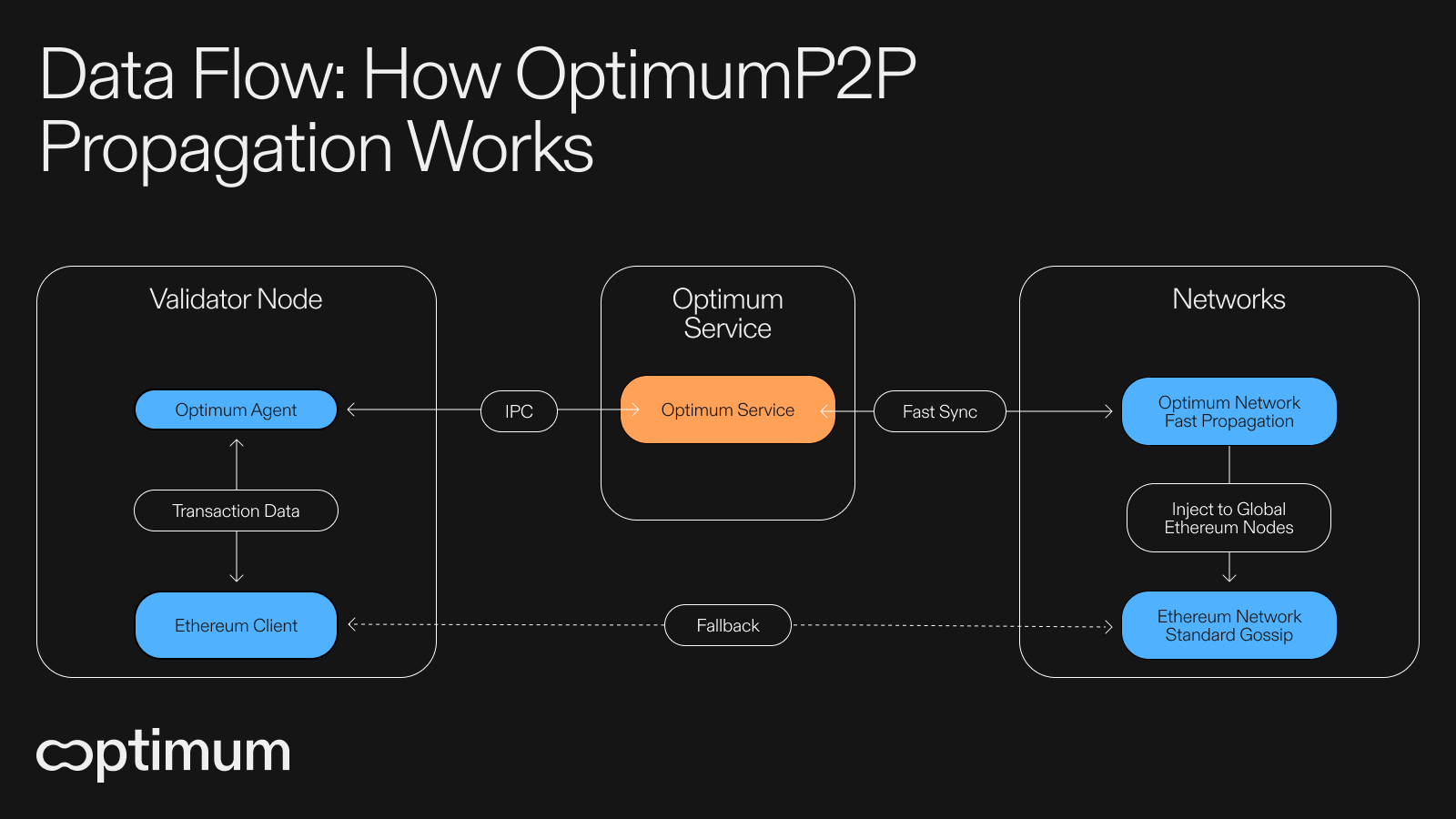
Important note: Ethereum validators can still perform standard data propagation (Gossipsub) alongside OptimumP2P, and will still use it to communicate with nodes that aren’t running OptimumP2P.
Effects of OptimumP2P Adoption: Speeds Increase, Costs Decrease
Now that we’ve established how OptimumP2P functions, let’s talk about why fast data propagation matters. Four groups of stakeholders are set to benefit from OptimumP2P; validators, the chain itself, app builders, and end users.
For validators, efficient, consistently fast propagation leads to higher APYs and lower operating costs. These economic effects that can be passed through to stakers as well. OptimumP2P propagation is significantly less bandwidth intensive than standard gossip, due to RLNC’s advantages (coded data sharding, timeslot efficiency). This means validators use less compute resources per data transmission, which lowers operating costs. Fast propagation is also important for block proposing, as slow propagation can mean a validator’s proposed block does not get included in the ledger, in which case they would lose out on block rewards. Being slow to receive new transactions could affect the ability to build MEV-optimized blocks, another source of validator revenue. We’re looking to better quantify these effects on validator economics as testnet progresses, and look forward to sharing our findings.
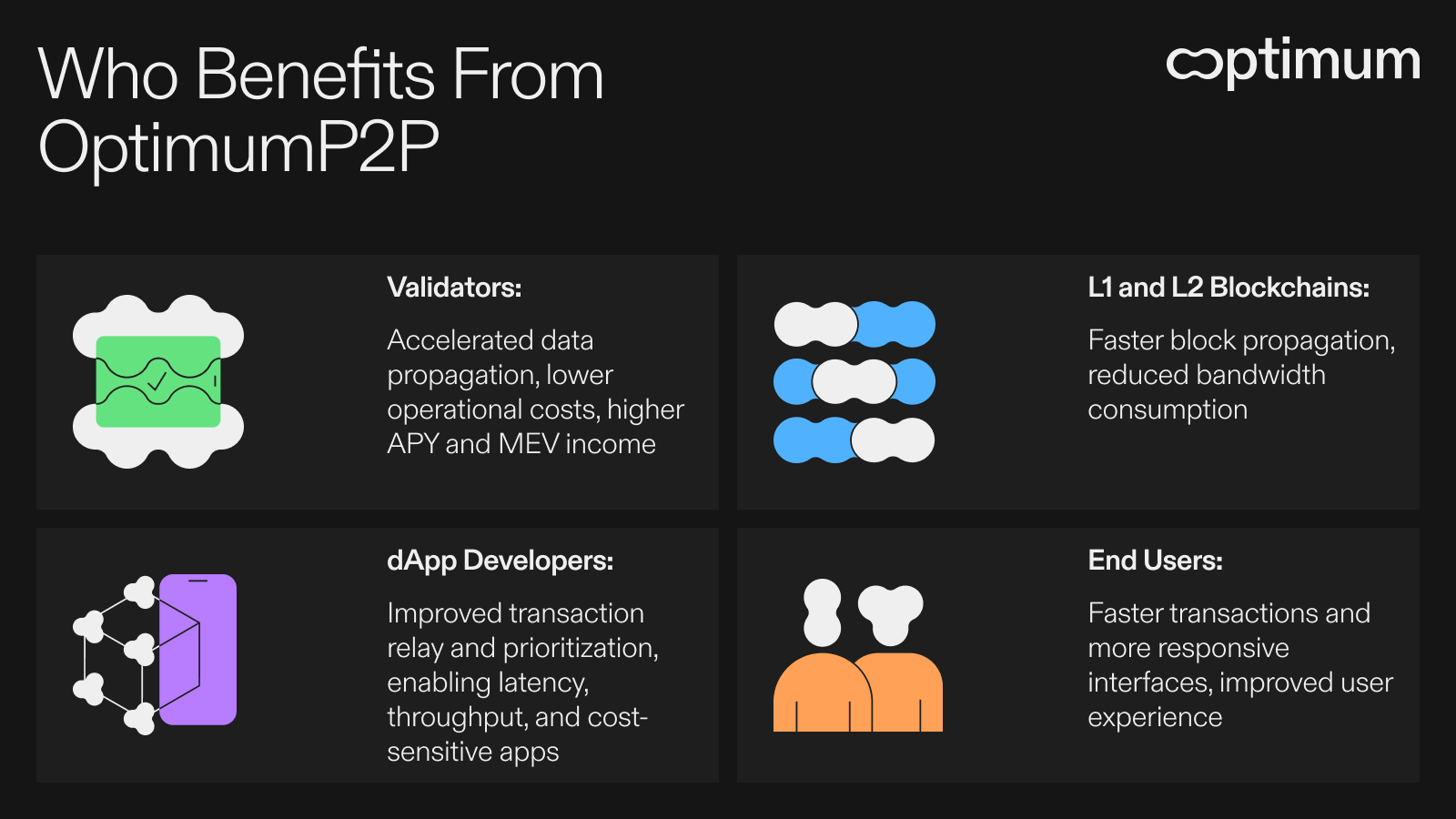
Efficiently using validator bandwidth enables scaling while retaining decentralization. RLNC-based propagation scales extremely well, maintaining high throughput across larger data sizes and higher frequencies than Gossipsub is capable of. This resource efficiency also means decentralization isn’t sacrificed as lower spec nodes can still participate effectively, as opposed to hardware-based scaling solutions that could push the network towards centralization. With regard to L2s, higher blob throughput enabled by OptimumP2P will improve rollup scaling in parallel with L1 scaling.
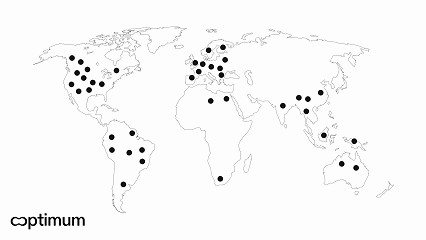
It’s important to note the potential of OptimumP2P to increase bandwidth & reduce latency operates under a network effect. As more nodes adopt OptimumP2P, data propagation speed and efficiency across the network rises, with maximum benefits being realized at full network adoption.
Now let’s look further downstream at how these performance gains are passed down to the application and user levels.
Second-order effects of OptimumP2P are felt at the application and end user levels. For app developers, OptimumP2P makes every interaction between the application & the chain quicker, moving closer to real-time performance. Milliseconds matter, and OptimumP2P opens the door for new use cases that require extremely low latency and high bandwidth.
OptimumP2P will be invisible to end users, as all good infrastructure should. Everything will simply feel faster. It’s a major quality of life improvement onchain, especially during periods of high congestion. The beautiful thing about RLNC based propagation is it doesn’t slow down when there’s more traffic on the network, throughput remains consistently high.
What’s Next?
We are currently in private testnet with a group of Ethereum node operators, where we’ve already been able to demonstrate 50%+ latency reduction vs. Gossipsub in a globally distributed network. We look forward to sharing more data and announcements from this round of testing soon. The next step is Hoodi Testnet, where we’ll get a much clearer picture of the scaling potential OptimumP2P can bring to Ethereum.
Time to scale the chains.